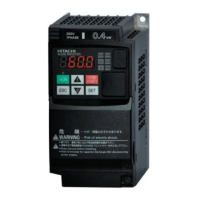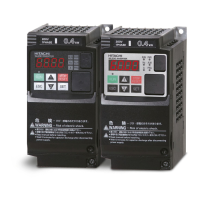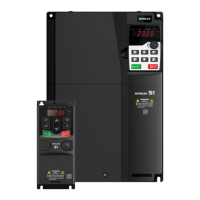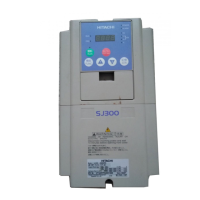Chapter 17 Specifications/Dimensions/Derating
17-1-5
Open collector output 2 terminals, 1c contact relay 1 terminal (the following functions can be
assigned to each output terminal):
RUN (Running), FA1 (Constant-frequency reached), FA2 (Set frequency overreached),
OL1 (Overload warning notice), AL (Alarm), FA3 (Set frequency reached),
OTQ (Over-torque/under-torque), TRQ (Torque limited), RNT (Accumulated RUN time over),
ONT (Accumulated power-on time over), THM (electronic thermal alarm (Motor)),
BRK (Brake release), BER (Brake error), ZS (Zero speed detection), DSE (Speed over deviation),
POK (Positioning completed), FA4 (Set frequency overreached 2), FA5 (Set frequency reached 2),
OL2 (Overload warning notice 2), Ai1Dc (Analog [Ai1] disconnection detection),
Ai2Dc (Analog [Ai2] disconnection detection), FBV (PID feedback comparison),
NDc (Communication line disconnection), LOG1 to 3 (Logical operation result 1 to 3),
WAC (Capacitor life warning), WAF (Cooling-fan life warning), FR (RUN command active),
OHF (Cooling fin overheat warning), LOC (Low current signal),
MO1 to 3 (General-purpose output 1 to 3), IRDY (Inverter ready), FWR (Forward rotation),
RVR (Reverse rotation), MJA (Major failure), WCAi1 (Window comparator [Ai1]),
WCAi2 (Window comparator [Ai2]), FREF (Frequency reference by keypad),
REF (RUN command by keypad), SETM (2nd-motor control is selected),
EDM (STO state monitor output), OPO (Option output), FSC (STO input discrepancy),
no (No assignment)
Functional safety EDM
output
STO confirmation output (Output terminal 11 is switched to [EDM] by slide switch)
2 terminals ([Ao1] terminal: 0 to 10 VDC analog voltage output, [Ao2] terminal: pulse output (max.
32 kHz)/10 VDC output)
Not built-in (optional external filter can be connected)
ND (normal duty):-10 to 50°C/ LD (light duty):-10 to 40°C
20 to 90% RH (non-condensing)
10 to 57 Hz: amplitude 0.075 mm
57 to 150 Hz: 9.8 m/s
2
(1.0 G)
Altitude: 1000 m or less, indoors (free from corrosive gases, oil mist, and dust)
The design life of the electrolytic capacitor on the board and the main circuit smoothing capacitor is
10 years.
The design life of cooling fan is 10 years (models with cooling fan) with no dust.
Non-volatile momory parts on control circuit board.
Conformity standards *10)
CE: EN61800-3:2004 / A1:2012 (EMC-filter option required), EN61800-5-1: 2007
UL: UL61800-5-1, -Overvoltage Category 3, -Pollution Degree 2
Others: c-UL
Functional safety: STO (Safe torque off) function/IEC 61508-5-2:2016, EN 61800-5-2:2017: SIL 3,
EN ISO 13849-1:2015: CAT. 3 PL e,
IEC 60204-1:2016: Stop Cat. 0
One unit can be mounted (existing communication options for WJ200 can be mounted)
Other optional components
Noise Filter, DC link choke, AC reactor, Braking resistor, Regenerative braking unit, Remote operator
(OPE-SR/OPE-SBK/OPE-SR mini/WOP), Inverter configuration software ProDriveNext, etc.
*1) The output frequency range depends on the control mode and the motor used. Consult the motor manufacturer
for the maximum allowable frequency of the motor when operating beyond 60Hz.
*2) In case that the control mode is changed and the motor constant settings are not appropriate, the desired starting
torque cannot be obtained and also exists the possibility of tripping.
*3) Contact your supplier or local Hitachi sales office when driving SM/PMM.
*4) Input power monitor and output power monitor are reference values. They are not suitable for calculation of
efficiency values, etc. To obtain an accurate value, use an external device.
*5) When a driver error [E30] occurs by the protective function, it may have happened by the short-circuit protection,
but also can occur if the IGBT is damaged. Depending on the operating conditions of the inverter, an overcurrent
error may occur instead of a driver error.
*6) At factory setting, the maximum output frequency for analog input signal [Ai1] is adjusted to 9.8 VDC for voltage
input and [Ai2] is adjusted to 19.8 mA for current input. To change the characteristics, refer to the analog
start/end function.
*7) Analog monitor output is a reference output for analog meter connection. The maximum output value may deviate
slightly due to variations in the connected meters and analog output circuits. To change the characteristics, use
[Ao1] adjust function.
*8) The storage temperature is the temperature during transportation.
*9) In case of installing at an altitude of 1000m or more, the atmospheric pressure decreases by approximately 1% for
every 100 m altitude increase. Apply 1% current derating from the rated current by increasing every 100 m, and
conduct an evaluation test. When using at an altitude of 2500 m, please contact your supplier or local Hitachi
sales office.
*10) Insulation distance conforms to UL and CE standards.

